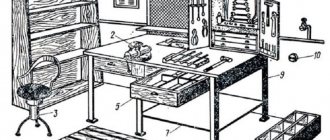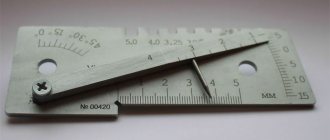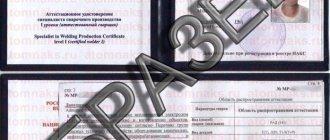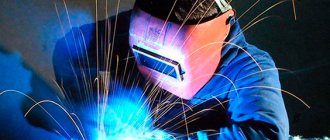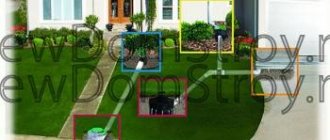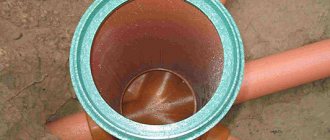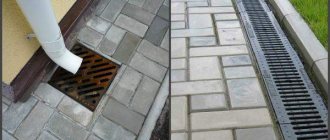The profession of a welder is not as simple as it may seem to the average person at first glance. Otherwise, special certification would not have been carried out, there would have been no qualification tests of specialists’ knowledge to extend their rank or increase it. So we can say that the work of a welder is responsible and complex, because it is he who performs labor-intensive and important welded joints and seams. A mandatory element required by highly qualified specialists is the welder’s mark. We'll talk about it today.
Type and code
In some cases, the first letters of the welder's last name or a series of numbers are used as identification. But most often the welder’s mark code is generated automatically. The basis is the specialist’s date of birth, his last name, first name and patronymic. Usually the mark does not change either during renewal, or when passing certification, or when changing the welding method.
There are several versions of the instrument. For example, numbers in two lines - without a frame or with a frame, numbers in a triangle, rhombus or square. The height of the symbols is usually 6 millimeters, however, in cases where the welder performs special work, a larger or smaller mark may be used. It is worth noting that this circumstance must first be discussed with management!
Marking welds instructions - Metalworker's Handbook
We offer production according to your individual drawing or sketch of a welder's mark for marking welds and metal structures. The welder's mark is made using the same technology as the impact mark and is a metal rod made of U8A tool steel with a hardening hardness of 52-56 HRC.
On one side of the rod a mirrored alphabetic and numerical designation is engraved, the other is intended for striking. After applying the image to the working part of the welder's mark, it is hardened in a high-temperature industrial furnace, after which the mark is ready for use.
As a result of the impact, a direct relief image remains on the product.
The welding mark, which is made in accordance with GOST 25726-83, must contain letters and numbers measuring about 6 mm. In the case of special work, it is allowed to use a sign of a larger or smaller size, and this circumstance is discussed with the management of the organization and made known.
The main rule of welder identification is that when stamping metal products, it is not allowed to form riveting, welding, or reduce the thickness of the metal; the imprint itself must be readable and neat. The safety of markings must be at the highest level throughout the entire period of operation of the structure.
Why do you need a stamp?
When welding particularly critical metal structures, certified welders make an impression with their mark next to the welded seam. This procedure is a sign of confirmation that a certain connection has been completed by the welder whose stamp numbers are applied to this product. That is, the assignment of a welder’s mark can be called the assignment of a kind of signature that confirms the high-quality performance of welding work.
It is impossible to confuse welders - each mark is called personal because it bears an individual number. If some kind of defect or defect was suddenly discovered, the mark could be used to identify the performer who performed poor-quality work. By the way, on October 8, 2014, federal norms and rules regulating certain requirements for work at hazardous facilities came into force. Thanks to this innovation, a single database has appeared that contains information about all certified welders. The database contains information about the position, date of certification and its field, code of the welder's mark, category, type of activity.
Marking of welds GOST
Welding is a profession that requires great attention and responsibility. When a welder performs important work, management must be sure that all welded joints are performed correctly.
However, how can an inspection reveal who carried out certain welding works? A welder's mark helps resolve this issue quickly and without problems.
This requirement was legislatively approved a long time ago, but in connection with the entry into force of new norms and regulations in the field of industrial safety, some changes have appeared regarding the welder's mark.
In general, the order of the Federal Service for Environmental, Technological and Nuclear Supervision is aimed at enhancing the quality of work and minimizing all kinds of violations when working with heavy metal structures at hazardous production facilities. At the same time, much attention in the FNP “Welding at HPF” is paid specifically to the identification of the worker who performed the welding activities.
Why is a welder's mark necessary?
Metal structures are used throughout the construction of most industrial buildings. The elements are connected to each other using welding. It is impossible to unambiguously determine whether the seam will be strong and durable - this is done by the inspection commission.
A timely identified defect allows you to avoid huge expenses associated with deformation and collapse of metal structures.
Therefore, when performing work related to surfacing, welding at hazardous production facilities, each welder is required to put his own code next to the work performed - a mark that allows you to quickly determine who owns the work with the identified violation.
Federal rules and regulations, which are aimed at safe operation in difficult production facilities, came into force on October 8, 2014.
Until this time, identification numbers were already widely used, but there was no single database from which one could find out all the necessary information about the welder: position, date of certification, type of activity, area of certification.
Type and code of the mark
The welder's mark is a metal rod, which is made of tool steel with a hardening hardness of 55-60 HRC. The rod, one side of which is flat and the other with an engraved image, is subjected to an impact, in place of which a clear relief is formed.
After the documented approval of the code to each employee, the organization must provide impact stamps.
In some cases, the first letters of the surname or numbers are used as identification, but most often the code is generated automatically, without changing during renewal, certification or changing the welding method.
The mark code is assigned to the welder - this avoids confusion that may arise in the future.
The welding mark, which is made in accordance with GOST, must contain letters or numbers measuring about 6 mm. In the case of special work, it is allowed to use a sign of a larger or smaller size, and this circumstance is discussed with the management of the organization and made known.
The main rule for identifying a welder is that when branding metal structures, there should be no work hardening, hardening or reduction in the thickness of the metal. The safety of markings must be at the highest level throughout the entire period of operation of the structure.
Where and in what cases is it placed?
In accordance with paragraph 21 of the FNP “Welding at hazardous production facilities”, all welded joints with a wall thickness of more than 6 mm must be marked with identification numbers of the welders who performed the work. Also, according to GOST 25225-82, the welder is obliged to indicate the place of work performed with a mark or brand.
Typically, the welder's mark is affixed on vertical structures, when connecting metal beams, in the case of fastening a ceiling base - there can be a huge number of options.
It is also worth noting that in the case of fastening reinforcement or welding elements with a thickness of less than 6 mm, the use of a mark is not necessary - in this case it is necessary to apply the requirements of production technical documentation.
The welder, immediately after carrying out welding work at hazardous production facilities, is required to affix a mark next to the completed seam. At the same time, a log of welding work, test reports of welded joints are filled out, and all the executive documentation required by law is drawn up.
The Federal norms and rules also contain a clause stating that when welding operations are performed by one welder, it is not necessary to indicate the identification code on all seams.
This is explained by the fact that the construction plan already contains a designation of the person performing the work - to avoid repetition and eliminate unnecessary red tape, it is enough to indicate the mark code in a place accessible for inspection, while enclosing it in a frame with indelible paint.
At the same time, if several workers worked on one weld of high complexity at once, it is necessary for each welder to leave his own code.
Welder's mark
We offer production according to your individual drawing or sketch of a welder's mark for marking welds and metal structures. The welder's mark is made using the same technology as the impact mark and is a metal rod made of U8A tool steel with a hardening hardness of 52-56 HRC.
On one side of the rod a mirrored alphabetic and numerical designation is engraved, the other is intended for striking. After applying the image to the working part of the welder's mark, it is hardened in a high-temperature industrial furnace, after which the mark is ready for use.
As a result of the impact, a direct relief image remains on the product.
The welding mark, which is made in accordance with GOST 25726-83, must contain letters and numbers measuring about 6 mm. In the case of special work, it is allowed to use a sign of a larger or smaller size, and this circumstance is discussed with the management of the organization and made known.
The main rule of welder identification is that when stamping metal products, it is not allowed to form riveting, welding, or reduce the thickness of the metal; the imprint itself must be readable and neat. The safety of markings must be at the highest level throughout the entire period of operation of the structure.
Where and when are they stamped?
According to paragraph 21 of the FNP “Welding at HPFs,” welded joints whose walls are thicker than 6 millimeters must be marked with the number of the welder who performed the work. And according to GOST 25225-82, the welder must mark his place of work with his mark.
Where exactly is it customary to place the mark? Primarily on the following structures:
- metal channels and beams;
- ceiling bases;
- It is possible (but not necessary) to use a stamp in fastening reinforcement or welding elements less than 6 millimeters.
After completing welding work at hazardous production facilities, the welder is required to affix a mark next to the completed seam. After this, it is necessary to fill out a work log and connection test reports.
Marking welds instructions
We offer production according to your individual drawing or sketch of a welder's mark for marking welds and metal structures. The welder's mark is made using the same technology as the impact mark and is a metal rod made of U8A tool steel with a hardening hardness of 52-56 HRC.
On one side of the rod a mirrored alphabetic and numerical designation is engraved, the other is intended for striking. After applying the image to the working part of the welder's mark, it is hardened in a high-temperature industrial furnace, after which the mark is ready for use.
As a result of the impact, a direct relief image remains on the product.
The welding mark, which is made in accordance with GOST 25726-83, must contain letters and numbers measuring about 6 mm. In the case of special work, it is allowed to use a sign of a larger or smaller size, and this circumstance is discussed with the management of the organization and made known.
The main rule of welder identification is that when stamping metal products, it is not allowed to form riveting, welding, or reduce the thickness of the metal; the imprint itself must be readable and neat. The safety of markings must be at the highest level throughout the entire period of operation of the structure.
Welder's mark code
Each welder carrying out his labor activity at industrial safety facilities is assigned an individual brand code, in other words, his personal sign, which is a kind of signature of the work performed.
The welder's mark is assigned during certification. The mark code is assigned to the welder - this avoids confusion.
An order to assign a mark to a welder is written in any form, which may indicate the types of structures being welded and additional powers of the performer.
https://www.youtube.com/watch?v=yww-vPMWEAA
After documentary approval of the code to the employee, the organization must provide impact stamps.
In some cases, the first letters of the last name or numbers are used as identification, but most often the code is generated automatically based on the welder’s full name and date of birth, without changing when renewing, passing certification or changing the welding method.
There are several options for welding marks: numbers in two lines without a frame, numbers in two lines with a frame, numbers in a rhombus, square, equilateral triangle and without them. All characters have a font height of 3 to 5 mm.
Federal rules and regulations, which are aimed at safe operation in difficult production facilities, came into force on October 8, 2014.
Until this time, identification numbers were already widely used, but there was no single database from which one could find out all the necessary information about the welder: employee’s position, certification date, brand code, category, type of activity, certification area.
Information about welder mark codes must be posted in the public register of certified personnel on the Internet. The brand codes assigned during certification must be assigned to welders by order of the organization performing welding work.
If the welder was certified before the FNP “Welding at hazardous production facilities” came into force, then he will retain the mark that was issued to him earlier and enshrined in the order of the enterprise. It is valid until the next certification, and then, after passing it, a new mark is issued in accordance with the requirements of the Federal Tax Service.
Why do you need a welder's mark?
Welding is a profession that requires great attention and responsibility.
When a welder performs important work, management must be sure that all welded joints are correctly completed.
However, how can an inspection reveal who carried out certain welding works? A welder's mark quickly helps resolve this issue. This requirement was approved by law.
https://www..com/watch?v=ZbnEIr5ITFc
Metal structures are used everywhere in the construction of most industrial buildings and structures. The elements are connected to each other using welding. It is impossible to unambiguously determine whether the seam will be strong and durable - this is done by the inspection commission.
A timely identified defect allows you to avoid huge expenses associated with deformation and collapse of metal structures. Therefore, when performing work related to surfacing, welding at hazardous production facilities, each welder is required to put his own code next to the work performed - a mark that allows you to quickly determine who owns the work with the identified violation.
How to get a welder's mark?
The welder's mark is a mandatory element of a worker certified by the National Welding Control Agency (NAKS).
The structural unit of the welding production certification system, after successfully passing all tests, issues a mark code along with an attestation certificate.
In accordance with the requirements of NAKS, welders are allowed to perform work that is documented.
Welder's mark. Where and why is it placed?
Welding is a profession that requires great attention and responsibility. When a welder performs important work, management must be sure that all welded joints are performed correctly.
However, how can an inspection reveal who carried out certain welding works? A welder's mark helps resolve this issue quickly and without problems.
This requirement was legislatively approved a long time ago, but in connection with the entry into force of new norms and regulations in the field of industrial safety, some changes have appeared regarding the welder's mark.
In general, the order of the Federal Service for Environmental, Technological and Nuclear Supervision is aimed at enhancing the quality of work and minimizing all kinds of violations when working with heavy metal structures at hazardous production facilities. At the same time, much attention in the FNP “Welding at HPF” is paid specifically to the identification of the worker who performed the welding activities.
Where and when are they stamped?
According to paragraph 21 of the FNP “Welding at HPFs,” welded joints whose walls are thicker than 6 millimeters must be marked with the number of the welder who performed the work. And according to GOST 25225-82, the welder must mark his place of work with his mark.
Where exactly is it customary to place the mark? Primarily on the following structures: metal channels and beams; ceiling bases; It is possible (but not necessary) to use a stamp in fastening reinforcement or welding elements less than 6 millimeters. After completing welding work at hazardous production facilities, the welder is required to affix a mark next to the completed seam. After this, it is necessary to fill out a work log and connection test reports.
How to put a stamp
Every certified welder should know how to apply a mark correctly. It is customary to place it at a distance of 20-50 millimeters from the edge of the weld. It is necessary to put a stamp on the outside. If the seams on the outer and inner sides are welded by different specialists, the marks are placed on the outer side - through the shot. The numerator is the mark of the specialist who welded the parts from the outside, the denominator, in turn, is the welder on the inside.
For longitudinal seams, the welder's mark must be placed at the beginning of the seam and at its end. It is important to maintain a distance of 100 millimeters from the circumferential seam. If the welder performed a circumferential seam, he knocks out a mark at the intersection of the circumferential seam with the longitudinal ones. The mark is repeated every two meters. It is worth noting that each such seam must have at least two marks. The place where each seam is branded must be enclosed in a clearly visible frame of indelible paint.
Another point of the Federal norms and rules states: if all welding work at a site is carried out by one welder, there is no need to indicate an identification code on each connection. One stamp, located in a place accessible for inspection, is enough. At the same time, if several specialists were working on one complex connection, everyone should leave their own cipher.
How and where to get a stamp
Assigning a mark to a welder, a sample order for which you can see below, is a rather complicated process. To do this, it is necessary to undergo certification by NAKS - the National Welding Control Agency. This agency is a structural division of SASv - the so-called Welding Certification System.
In order to pass certification, you must successfully pass various tests. Only after this, along with the certification certificate, the welder is given a mark code.
Please note: a mark that was issued before the Federal Tax Code came into force is valid only until the next certification. If it is successfully completed, the specialist receives a new one that meets the new standards.
Order on assigning a mark to a welder: sample, form
Clause No. 8 of the FNP states that after brand codes are assigned to welders, they are assigned to these specialists. The order is signed by the organization performing the welding work. We bring to your attention a sample order for a welder's mark.
Nothing complicated, as you can see. In addition, the order to assign a personal brand is usually written in free form. It may indicate the types of structures being welded and other powers of the welder.
